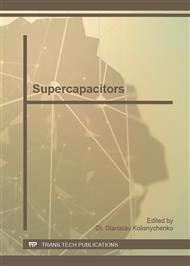p.669
p.674
p.680
p.685
p.689
p.693
p.698
p.704
p.709
Recycling of Waste Toner and its Electrochemical Performances for Supercapacitor
Abstract:
Utilization of the waste toner in wasted print cartridge was beneficial to the environmental protection and resource recycling. Fe3O4 has been obtained from the waste toner via magnetic separation and heat-treatment in present study. XRD measurement revealed the recuperated sample has ferriferrous oxide structure without other crystalline impurity. The electrochemical performances of recuperated Fe3O4, as the electrode active material for supercapacitor, was conducted by cyclic voltammetry and charge-discharge process. The results showed that the specific capacitance of Fe3O4 achieved 76.5 F/g under 50 mA/g current density, which possessed typical capacitive behaviors and good cycling stabilities. Based on the preferable electrochemical performances, Fe3O4 recovered from waste toner may be a potential alternative as electrode material for supercapacitor.
Info:
Periodical:
Pages:
689-692
Citation:
Online since:
October 2014
Authors:
Keywords:
Price:
Сopyright:
© 2014 Trans Tech Publications Ltd. All Rights Reserved
Share:
Citation:



